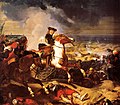Charles-Philippe Larivière
Charles-Philippe Larivière (born September 28, 1798 in Paris , † February 29, 1876 in Paris) was a French academic painter and graphic artist, best known for his depiction of historical events .
life and work
Larivière came from a family of artists. His grandfather was the painter Charles Lepeintre (1785-1803). His brother Louis-Eugène Larivière (approx. 1801–1823) was also a painter
Charles-Philippe Larivière began his training at the renowned École des Beaux-Arts in 1813 when he was less than fifteen . He studied with well-known teachers such as Anne Louis Girodet-Trioson and Antoine-Jean Gros .
Despite his neoclassical training, he soon opened up to the influences of the romantic school . As subjects , he chose scenes from French history, especially the Ancien Régime and the Middle Ages , which, as a good patriot, he always portrayed in a positive light. This earned him numerous lucrative government contracts. Four Larivière battle paintings alone can be seen in the Palace of Versailles (three in the Battle Gallery and one in the Salles des Croisades, which opened in 1843 ). These halls were aimed at the historical Salle de 1830 , which glorified the July Revolution and the citizen king Louis-Philippe , who had come to power through them. Larivière's monumental depiction of the scene hung here as Louis-Philippe went on horseback on July 30, 1830 to the cheering of the population for the decisive consultations with the Republicans in the Paris City Hall. In reality, Louis-Philippe had walked and there had been no public cheers. The king liked the picture exceptionally: When the painting was presented, he praised Larivière as “the author of my large picture”. Larivière also painted several portraits of historical figures for the rooms in Versailles dedicated to French history, for example the Grand Master of the Order of Malta Jean Parisot de la Valette and the Marshals of France Count Rochambeau , Bugeaud de la Piconnerie and Saint-Arnaud . His portrait of General de La Brunerie hung in the stairwell of the Pavillon du Roi in Vincennes Castle .
Larivière also dealt with religious art: he designed the interior of a chapel dedicated to Saint Eustachius and made preliminary drawings for the stained glass windows in the Chapelle royale in Dreux .
Awards
At the age of 21 he won a second prize at the Prix de Rome of the Académie des Beaux-Arts , in 1820 he won a recognition award. In 1824 he won the first prize of the Prix de Rome with his large-format death of Alcibiades , which enabled him to work in the Villa Medici in Rome from 1824 to 1830 . In 1825 Larivière exhibited for the first time in the Salon de Paris , where he won medals in 1827 and 1855. In 1836 he was accepted into the Legion of Honor . He was also awarded the Ordre du Nicham Iftikar de Tunisie .
gallery
The death of John Talbot in the Battle of Castillon
Individual evidence
- ^ Carsten Kretschmann, A toutes les gloires de la France. Louis-Philippe and the Galerie des Batailles in Versailles , in: Carsten Kretschmann (ed.), Popularization of knowledge. Concepts of knowledge dissemination in transition , Akademie-Verlag, Munich 2003, p. 193
- ^ Albert Boime , Art in an Age of Counterrevolution (1815-1848). A Social History of Modern Art , Vol. 3, University of Chicago Press, Chicago 2004, pp. 302f
literature
- Louis Gustave Vapereau : Dictionnaire universel des contemporains . Hachette, Paris 1880.
Web links
- Charles-Philippe Larivière on bilder-geschichte.de
| personal data | |
|---|---|
| SURNAME | Larivière, Charles-Philippe |
| BRIEF DESCRIPTION | French academic painter and printmaker |
| DATE OF BIRTH | September 28, 1798 |
| PLACE OF BIRTH | Paris |
| DATE OF DEATH | February 29, 1876 |
| Place of death | Paris |





